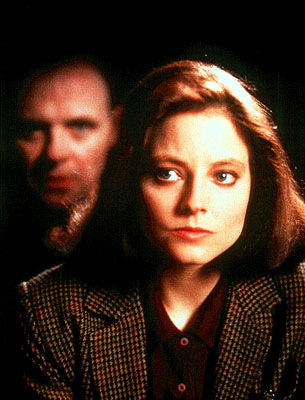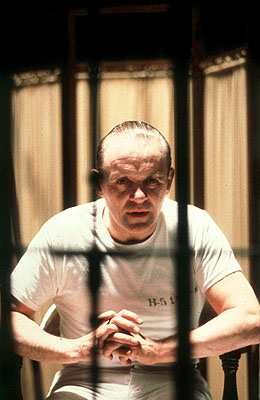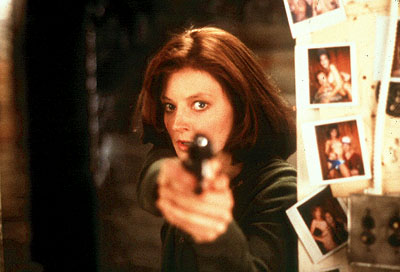The Silence of the Lambs (1991)
DIRECTOR: Jonathan Demme
CAST:
Jodie Foster, Anthony Hopkins, Scott Glenn, Ted Levine, Anthony Heald, Diane Baker, Brooke Smith, Chris Isaak, Charles Napier, Daniel von Bargen
REVIEW:
Few cinematic villains are a source of as much morbid fascination as Hannibal Lecter. Like the heroine Clarice Starling, we are frightened and disturbed by him, and yet we are too intrigued to turn our eyes away. Dr. Lecter is undoubtebly the character best-remembered from the psychological thriller The Silence of the Lambs, and the acclaim showered on Anthony Hopkins for his Oscar-winning performance sometimes threatens to overshadow Jodie Foster’s also Oscar-winning lead role as FBI trainee Clarice Starling, a fine performance and a well-developed character in her own right. Clarice and Hannibal are two of the strongest characters ever written and acted in a horror movie, and they are given a script that does them justice, a dark, intelligent thriller that relies much less on blood and guts than on well-honed characterizations, a few scenes of indelible purely verbal interactions, and a vivid sense of atmosphere. All of these elements combined to make The Silence of the Lambs a classic of the thriller genre and earned it five Academy Awards in 1991.
 While Hannibal is the most iconic character, the lead and really the backbone of the film is Clarice Starling (Jodie Foster, sporting dark hair and a West Virginia accent), a bright-eyed but emotionally vulnerable FBI trainee who is called on by FBI Chief Jack Crawford (Scott Glenn) to assist in the psychological evaluations of imprisoned serial killers for possible insight into a string of grisly murders perpetrated by a mysterious and twisted individual known only as Buffalo Bill (Ted Levine) for skinning his female victims. The brightest and most sought-after of the bunch, former distinguished psychiatrist Dr. Hannibal Lecter (Anthony Hopkins) ignores all attempts at evaluation. Yet something about this bright, eager, but insecure young woman sparks Hannibal’s interest and perhaps even a degree of sympathy. He agrees to help her catch Buffalo Bill, but only in exchange for information on her private life. The intense psychological interplay between Clarice and Hannibal is the centerpiece of the film, as Clarice is forced to confront her own inner demons and insecurities, even as she must race against time to save the daughter (Brooke Smith) of a US Senator (Diane Baker) who has been abducted by Buffalo Bill.
While Hannibal is the most iconic character, the lead and really the backbone of the film is Clarice Starling (Jodie Foster, sporting dark hair and a West Virginia accent), a bright-eyed but emotionally vulnerable FBI trainee who is called on by FBI Chief Jack Crawford (Scott Glenn) to assist in the psychological evaluations of imprisoned serial killers for possible insight into a string of grisly murders perpetrated by a mysterious and twisted individual known only as Buffalo Bill (Ted Levine) for skinning his female victims. The brightest and most sought-after of the bunch, former distinguished psychiatrist Dr. Hannibal Lecter (Anthony Hopkins) ignores all attempts at evaluation. Yet something about this bright, eager, but insecure young woman sparks Hannibal’s interest and perhaps even a degree of sympathy. He agrees to help her catch Buffalo Bill, but only in exchange for information on her private life. The intense psychological interplay between Clarice and Hannibal is the centerpiece of the film, as Clarice is forced to confront her own inner demons and insecurities, even as she must race against time to save the daughter (Brooke Smith) of a US Senator (Diane Baker) who has been abducted by Buffalo Bill.
Undoubtedly, a lesser performer in the role of either Clarice or Hannibal would have diminished the film. Jodie Foster has said that, of all her many roles, Clarice Starling is her favorite, and it’s not hard to see why. Clarice is that rare movie character- a central female heroine. The film takes time to develop Clarice as a woman in a man’s world, both visually- an early scene of her getting into an elevator filled with men who tower over her- and emotionally, in a scene in which she accompanies Crawford to a small rural town and is treated with condescension by the local cops. She is haunted by her father’s murder and feels driven to save one innocent life now to overcome childhood memories of when she was unable to save lives. In a way, it could be said Foster has the harder job than Hopkins, as she has the low-key, non-flashy role that forms the true emotional center of the movie, but her understated performance never hits a false note. It’s debatable whether Foster delivers an Oscar-worthy performance, but she deserves more credit for the movie’s success than she often receives.
 As for her co-star, what can be said about Anthony Hopkins’ Hannibal Lecter? Hopkins develops Hannibal into quite possibly the most chilling movie character ever brought to the screen, all the more impressive feat when it’s taken into consideration that he has limited screentime (it feels like he’s in it more than he physically is) and spends almost all of it standing inside a prison cell. Hannibal is a brilliant psychiatrist, a cultured and educated man, polite, impeccably well-mannered, yet also a vicious and diabolical fiend. Hopkins’ undeniably scenery-chewing but controlled portrayal palpably radiates charismatic, sinister evil like few characters ever seen. Hopkins improvised his most memorable bits, including mocking Clarice’s West Virginia accent and following up one of the most famous and oft-quoted lines in movie history, ‘I ate his liver with some fava beans and a nice chianti’, with an inimitable slithering slurp. We get the sense that he is like a snake, coiled up and ready to strike, and Hopkins radiates such a formidable, deeply menacing presence that the bars which contain him seem like they may not be enough to protect us if he decides otherwise. Of course, he is the sort of serial killer that exists only in the movies- most real-life murderers are not half as intelligent as Lecter, but they also wouldn’t be half as interesting to talk to.
As for her co-star, what can be said about Anthony Hopkins’ Hannibal Lecter? Hopkins develops Hannibal into quite possibly the most chilling movie character ever brought to the screen, all the more impressive feat when it’s taken into consideration that he has limited screentime (it feels like he’s in it more than he physically is) and spends almost all of it standing inside a prison cell. Hannibal is a brilliant psychiatrist, a cultured and educated man, polite, impeccably well-mannered, yet also a vicious and diabolical fiend. Hopkins’ undeniably scenery-chewing but controlled portrayal palpably radiates charismatic, sinister evil like few characters ever seen. Hopkins improvised his most memorable bits, including mocking Clarice’s West Virginia accent and following up one of the most famous and oft-quoted lines in movie history, ‘I ate his liver with some fava beans and a nice chianti’, with an inimitable slithering slurp. We get the sense that he is like a snake, coiled up and ready to strike, and Hopkins radiates such a formidable, deeply menacing presence that the bars which contain him seem like they may not be enough to protect us if he decides otherwise. Of course, he is the sort of serial killer that exists only in the movies- most real-life murderers are not half as intelligent as Lecter, but they also wouldn’t be half as interesting to talk to.
The supporting cast is capable, but this is Foster and Hopkins’ movie. As the secondary serial killer onhand, Ted Levine is adequate with what he has, but that isn’t much; Buffalo Bill doesn’t have much screentime and is sketchily-developed (and what development he does get unfortunately verges on presenting a transsexual as a villainous psychopath). Compared to all the time and attention lavished on Lecter, Buffalo Bill is little more than a plot device. Scott Glenn has the unchallenging role of Jack Crawford, the kind of stoic mentor figure that could be filled out by any number of middle-aged character actors with authoritative presences. Low-profile character actor Anthony Heald does a good job being repellent as Hannibal’s oily, self-promoting keeper Dr. Chilton. In fact, in a movie that features two serial killers, there’s times when Heald’s Chilton might be the most off-putting person onscreen.
 Jonathan Demme’s sure-handed direction, aided by cinematographer Tak Fujimoto and production designer Kristi Zea, is so powerfully effective in establishing a dark and creepy atmosphere that it’s possible to forget that while not without a few shocking moments of gruesomeness, The Silence of the Lambs is actually restrained for the most part in its gore (certainly more so than its gleefully grotesque sequel, 2001’s Hannibal). Case in point is Clarice’s first meeting with Hannibal, descending down a dark hallway which looks and feels like the bowels of hell. The filmmakers effectively practice the ‘less is more’ approach when Dr. Chilton shows Clarice a photograph of the result of Hannibal’s vicious attack on a nurse but Demme never shows us the picture, letting suggestion speak louder than the image. In another scene between Clarice and Hannibal, the camera stays steadily on Clarice’s face while Hannibal’s is reflected in the glass, floating disembodied next to her. Clarice and Hannibal’s relationship quickly becomes far more complex and ambiguous than a straightforward interview. She is disturbed by him but undeniably intrigued as well, and he with her. He senses an intelligence and vulnerability, and he admires and sympathizes with her openness in detailing her traumatic childhood. This imprisoned serial killer becomes the person she opens up to (albeit not entirely willingly) as she has probably never done before in her life. He finds her worth talking to, and in the end he gives her the clues she needs to solve the case and in the process, provide herself with a sense of validation, because he deems her worthy of them. Clarice and Hannibal’s relationship is like an uneasy dance—neither could ever be conventionally close to the other, obviously, but it’s impossible to deny that there is a mutual fascination between them, and perhaps even an undertone of attraction (the Hannibal film made this more overt). On some level, Clarice and Hannibal connect.
Jonathan Demme’s sure-handed direction, aided by cinematographer Tak Fujimoto and production designer Kristi Zea, is so powerfully effective in establishing a dark and creepy atmosphere that it’s possible to forget that while not without a few shocking moments of gruesomeness, The Silence of the Lambs is actually restrained for the most part in its gore (certainly more so than its gleefully grotesque sequel, 2001’s Hannibal). Case in point is Clarice’s first meeting with Hannibal, descending down a dark hallway which looks and feels like the bowels of hell. The filmmakers effectively practice the ‘less is more’ approach when Dr. Chilton shows Clarice a photograph of the result of Hannibal’s vicious attack on a nurse but Demme never shows us the picture, letting suggestion speak louder than the image. In another scene between Clarice and Hannibal, the camera stays steadily on Clarice’s face while Hannibal’s is reflected in the glass, floating disembodied next to her. Clarice and Hannibal’s relationship quickly becomes far more complex and ambiguous than a straightforward interview. She is disturbed by him but undeniably intrigued as well, and he with her. He senses an intelligence and vulnerability, and he admires and sympathizes with her openness in detailing her traumatic childhood. This imprisoned serial killer becomes the person she opens up to (albeit not entirely willingly) as she has probably never done before in her life. He finds her worth talking to, and in the end he gives her the clues she needs to solve the case and in the process, provide herself with a sense of validation, because he deems her worthy of them. Clarice and Hannibal’s relationship is like an uneasy dance—neither could ever be conventionally close to the other, obviously, but it’s impossible to deny that there is a mutual fascination between them, and perhaps even an undertone of attraction (the Hannibal film made this more overt). On some level, Clarice and Hannibal connect.
The Silence of the Lambs is actually a relatively low-key, subdued thriller. The climax, as Clarice and Buffalo Bill finally end up under the same roof, is cleverly-handled and suspenseful, but there are no stunts or conventional chase scenes, no scrambling over rooftops or protracted gunfights, and no boo! moments when some banal object suddenly comes flying out of the shadows to make us jump in our seats. But there is an intelligent, restrained, and atmospheric film with two of the best characters ever to populate the thriller genre, including one of, if not the, greatest screen villains ever created, and the central aspect of the film, the encounters between Clarice and Hannibal, could not have been more well-crafted.
****